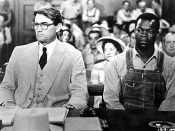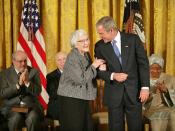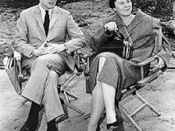"Courage is when you know you're licked before you begin, but you begin anyway and you see it through no matter what" According to Atticus Finch, an honest lawyer in Harper Lee's novel "To Kill a Mockingbird" teaches the children that courage can be portrayed as both physical bravery and strength, but fighting for what is right regardless of whether you win or lose takes more strength in character, and is ultimately more courageous. This is revealed to us by the children's original belief courage being physical, the idea of Ms Dubose's bravery and similarly, Atticus' strong moral courage. Atticus fits into this definition of what courage is and demonstrates it several times throughout the novel. Finally, Scout and Jem show courage of their own by challenging their former attitudes.
Scout and Jem learn from Atticus a very traditional sense of courage and masculinity. One of the first examples of physical courage Atticus sets is when he steps into the street to shoot the rabid dog.
Although he was completely uninterested in proving anything to his children, he showed them that you cant back down from a dangerous situation, if there's the chance for other people getting hurt. Another example of physical courage that Atticus demonstrates is when he camps out in front of the jail house where Tom Robinson is being kept. He did this because he knew what would happen to Tom if he didn't try to protect him. Atticus put someone else's life in front of his own showing great courage in the face of danger. Atticus understands that defending Tom is right thing to do so he camps out in front of the jail house to protect him. Through these examples, Atticus unknowingly reaffirms Scout and Jem's traditional, masculine views of courage.
These values are then however challenged by Mrs. Dubose, An old cantankerous lady who dies from a morphine addiction. She and Atticus taught Jem the concept of psychological courage as one of the strongest demonstrations of courage. For over a month, Atticus required Jem to read to the bitter lady. After her death, the children are told the real reason they were forced to read to her was not because of them destroying her rose garden. Their father claims that he wanted his children "to see what real courage is." Only after realising the true reason they were told to read to her, they begin to understand the immense psychological courage Mrs. Dubose undertook. Atticus then describes Mrs. Dubose as "the most courageous person he ever knew." This challenges the children's initial perception of courage. This psychological courage bears a strong likeness to the situation of Atticus' defence of Tom Robinson.
There are also examples of moral courage in the book that Atticus sets for his children. An example of Atticus using moral courage is when he decided to defend Tom Robinson. He knew the risks involved and how much pressure it would put on him and his family. He also knew the intense racial prejudices in Maycomb, making it almost impossible for him to win. Even knowing that, he still fights for Tom's innocence. That took real courage, and strength to stand up against the town to do what was right no matter what anybody said or did. Even with the numerous amounts of inconsistencies within the case, Tom is still found to be guilty. Atticus tried to show that courage is also a moral thing, not always something that you do physically. "I wanted you to see what real courage is, instead of getting the idea that courage is a man with a gun in his hand. It's when you know you're licked before you begin but you begin anyway and you see it through no matter what."
The reader sees representation of courage is a vital part of To Kill a Mockingbird. The attitudes and values of Scout and Jem were used to reveal key elements of courage. They first believe that courage is that of a physical sense, relating it to masculinity. They later learn through both the words and actions of Atticus and the harsh lesson taught by Mrs. Dubose that courage takes more than bravery and physical strength. It is both emotional and psychological. Given that, we learn that because Scout and Jem's realisation of real courage, they display to the reader courage within themselves.



To Kill a Mockingbird
This essay has a good thesis, is well-organized, and has good support for the argument.
2 out of 2 people found this comment useful.